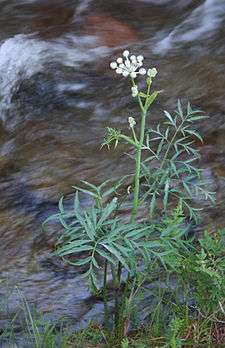Sphenosciadium
| Sphenosciadium Sphenosciadium capitellatum | |
|---|---|
 | |
| Scientific classification | |
| Kingdom: | Plantae |
| (unranked): | Angiosperms |
| (unranked): | Eudicots |
| (unranked): | Asterids |
| Order: | Apiales |
| Family: | Apiaceae |
| Genus: | Sphenosciadium A.Gray |
| Species: | S. capitellatum |
| Binomial name | |
| Sphenosciadium capitellatum A.Gray | |
Sphenosciadium is a monotypic genus of flowering plants in the carrot family containing the single species Sphenosciadium capitellatum, which is known by the common names woollyhead parsnip,[1] ranger's buttons, button parsley, and swamp white heads.
Distribution
The plant is native to western North America from Idaho through Nevada, Oregon, and California into Baja California. It grows in moist habitat types, such as creeksides and meadows. It is included in Toxic Plants of North America (Burrows & Tyrl, 2001).[2]
Ranger's buttons plants are quite similar to the other large Umbelliferae that share similar habitats: Sierra angelica and cow parsnip, but each has a very differently shaped leaf, and the other two have umbellets with quite distinct flowers, in contrast to the tight balls on ranger's buttons.[3]
Description

It is a stout perennial herb growing from a tuberous root and producing an erect stem often exceeding 1 meter (3.3 ft) tall and sometimes approaching 1.2 meters (3.9 ft). The stem and leaves are usually green but sometimes nearly white in color, smooth below but with rough hairs on the inflorescence. The leaves are divided into several segments which bear widely spaced leaflets. The leaflets may also be intricately divided into small segments (see image at left).
The inflorescence is a whitish compound umbel with many branches each up to 10 centimeters long. The nearly spherical, headlike terminal umbellets contain many tiny white or purple-tinged flowers, whose protruding stamens make them appear very fuzzy in full bloom, as for the central umbels in the top right image.
References
- ↑ "Sphenosciadium capitellatum". Natural Resources Conservation Service PLANTS Database. USDA. Retrieved 25 November 2015.
- ↑ George E. Burroughs; Ronald J. Tyrl (2001), Toxic Plants of North America (1st ed.), Iowa State Press, ISBN 0-8138-2266-1
- ↑ Norman F. Weeden (1996), A Sierra Nevada Flora (4th ed.), Wilderness Press, ISBN 0-89997-204-7
External links
| Wikimedia Commons has media related to Sphenosciadium capitellatum. |
- Jepson Manual Treatment: Sphenosciadium capitellatum
- USDA Plants Profile for Sphenosciadium capitellatum
- Sphenosciadium capitellatum — U.C. Photo gallery